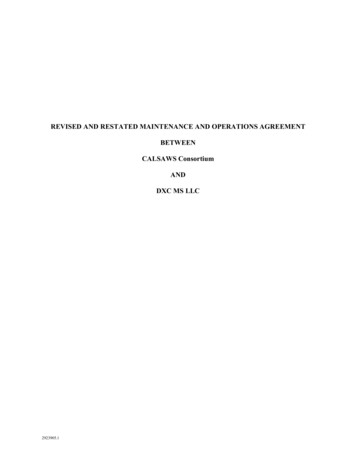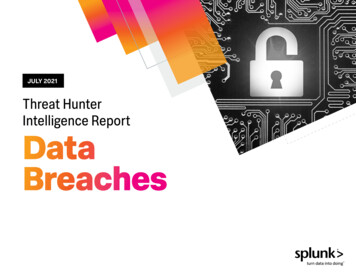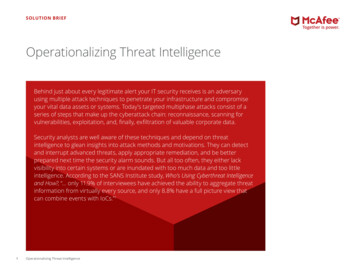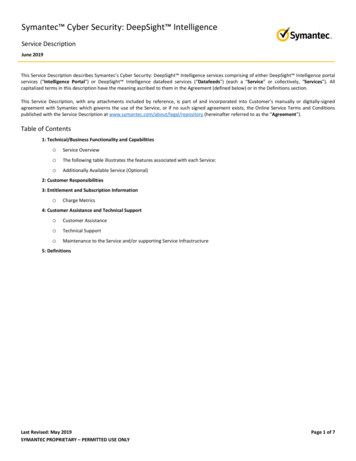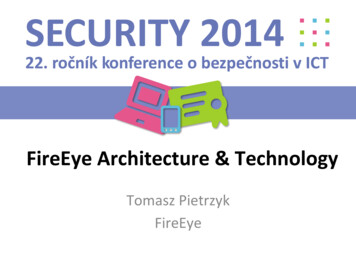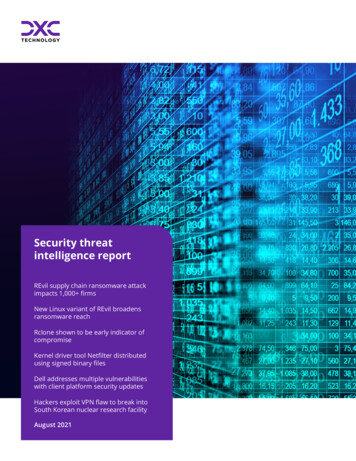
Transcription
Security threatintelligence reportREvil supply chain ransomware attackimpacts 1,000 firmsNew Linux variant of REvil broadensransomware reachRclone shown to be early indicator ofcompromiseKernel driver tool Netfilter distributedusing signed binary filesDell addresses multiple vulnerabilitieswith client platform security updatesHackers exploit VPN flaw to break intoSouth Korean nuclear research facilityAugust 2021
Message from Mark HughesTable of contentsThreat updatesREvil supply chain ransomwareattack impacts 1,000 firms3New Linux variant of REvilbroadens ransomware reach4Rclone shown to be earlyindicator of compromise6Kernel driver toolNetfilter distributed usingsigned binary files6Vulnerability updatesDell addresses multiplevulnerabilities with clientplatform security updatesRansomware is bad enough, but supply chain attacks amplifythe threat by enabling a single breach to affect downstreamcustomers. In one of the largest such attacks to date, thethreat group behind the REvil ransomware compromised ITservice supplier Kaseya, locking up accounts for hundreds ofcustomers across 17 countries. The key lesson: As good as youmight be at safeguarding against such attacks, you’re only asgood as your core suppliers.Mark HughesPresidentSecurityDXC Technology7Nation state and geopoliticalHackers exploit VPN flaw tobreak into South Koreannuclear research facilityAbout this report8Fusing a range of public and proprietary information feeds, including DXC’s globalnetwork of security operations centers and cyber intelligence services, this reportdelivers an overview of major incidents, insights into key trends and strategic threatawareness.Intelligence cutoff date:July 9, 20212
Threat updates1,000 REvil supply chain ransomware attack impacts1,000 firmsNumber of companies likelyinfected in the recent Kaseyasupply chain ransomware attackon-premises VSA remote monitoring and management software was compromisedSource: The Hacker NewsOn July 2, Kaseya, an information technology (IT) software company, announced itsin a cyber attack. Reports emerged that the Russia-linked REvil (aka Sodinokibi)had exploited zero-day vulnerabilities in Kaseya’s VSA software to conduct asupply‑chain ransomware attack against multiple Kaseya managed serviceproviders (MSP) and customers.Although VSA is the only product affected by the attack, Kaseya has also taken its 11MSaaS servers offline until further notice. According to Kaseya, approximately 40Amount JBS Holdings is said tohave paid in ransomware after arecent attackzero‑day vulnerability. Kaseya has also engaged security firm FireEye MandiantSource: The Wall Street Journalagencies, including the Cybersecurity and Infrastructure Security Agency (CISA) andof its direct customers were compromised in the attack, in addition to potentiallyaffecting 1,500 downstream businesses.As of July 5, Kaseya announced that it is developing a patch to address thewith the forensic investigation to assist in determining the root-cause of the attack.Furthermore, Kaseya has notified law enforcement and government cybersecurityFederal Bureau of Investigation (FBI).Organizations should assess the risk that exploitation of the Kaseya VSA product74%Percentage of companiessurveyed that said they arebeing affected by the shortage ofcybersecurity professionalsSource: Varonisposes to their environment. If Kaseya on-premises VSA is not used as an enterpriseIT management tool, the risk maybe low per the Kaseya advisory.BackgroundKaseya provides enterprise grade IT management software to MSPs and IT teams.According to Kaseya, exploitation of the VSA on-premises product began July 2 whencustomers reported the deployment of ransomware on their endpoints. All on-premisesKaseya customers were subsequently notified to shutdown their VSA servers. Thecompany also shut down its SaaS services until further updates can be released. At thistime, there are no indications that Kaseya’s VSA codebase has been maliciously modifiedor its SaaS solution exploited.Threat actors behind REvil operations claimed responsibility for the attack through itsdedicated leak site. CrowdStrike Intelligence believes the REvil group is likely operatingfrom Eastern Europe or the Russian Federation. The group sells access to its ransomwarethrough a ransomware-as-a-service model, which is a partnership program with eCrimeaffiliates. The exploitation chain in the Kaseya attack likely leveraged a combination ofauthentication bypass, arbitrary file upload, and code injection vulnerabilities to upload,distribute, and execute the REvil ransomware payload.3
Next StepsNew Chinese APTBackdoor Attack TargetsRussian Defense SectorDXC Technology will continue to monitor Kaseya, CISA and FireEye MandiantWhile analyzing newly discoveredRoyalRoad samples observed in thewild, the Cybereason NocturnusTeam detected one that not onlyexhibits anomalous characteristics,but also delivers PortDoor malware.This is a previously undocumentedbackdoor assessed to have beendeveloped by a threat actor likelyoperating on behalf of Chinesestate‑sponsored interests.Examination of available data relatedto the phishing lure revealed thetarget of the attack was a generaldirector working at the RubinDesign Bureau, a Russian‑baseddefense contractor that designsnuclear submarines for the RussianFederation’s Navy.RecommendationsSource: CybereasonEven as successful as the REvil Ransomware as a Service (RaaS) has been — withupdates to identify the full scope and residual risks of the ransomware attack, andDXC will continue to track the REvil threat actors TTPs.Institute system privilege policies that provide users the minimum privilegesnecessary to perform their functions. Further recommendations include: Limit personnel authorized to create privileged accounts Use a privileged account management (PAM) tool Implement privileged account monitoring and screen captureEnsure critical patches are installed on all systems as well as network infrastructure.Ransomware operators exploit vulnerabilities to escalate privileges in orderto deploy ransomware on a victim’s system. Enforce the use of multifactorauthentication.New Linux variant of REvil broadensransomware reachthe Kaseya attack reportedly being one of the largest ever — the group behind themalware has been observed revamping the tool to broaden its potential attacksurface.REvil has traditionally targeted Windows environments, but a new variant caninfiltrate Linux-based ESXi hypervisor infrastructure and NAS devices. ESXi makesit possible to share hard drives across multiple virtual machines (VM) so, oncecompromised, attackers can encrypt storage for broad swaths of systems. With NASdevices being shared resources, the same is true with these backend machines.REvil was first observed in April of 2019, according to AT&T Alien Labs, and the Linuxvariant was first reported in May of this year.Alien Labs reports that, before encrypting files, “REvil runs the esxcli command linetool to list all running ESXi VMs and terminate them. By doing this, the attackerensures no other VM is handling the files to be encrypted, avoiding corruption issuesof the encrypted files. However, the executable has a specific parameter to run insilent mode, which avoids debugging without stopping any VMs.”4
Published indicators of compromise include:SHA256 Hashes:Japanese Industrialorganizations targetedfor data exfiltrationSecurity researchers recentlydisclosed details of a campaignthat deploys malicious backdoorsfor the purpose of exfiltratinginformation from numerousindustrial targets in Japan. Dubbed“A41APT” by Kaspersky researchers,these attacks are “using previouslyundocumented malware to deliveras many as three payloads, such asSodaMaster, P8RAT, and FYAnti,”The Hacker News reports. TheTTP leverages a multi-stage attackprocess, with the initial intrusionhappening via abuse of SSL-VPN byexploiting unpatched vulnerabilitiesor stolen credentials.Source: The Hacker News e5acb92599fcd4 b19b505f965bc4 e725711db47763 50816ec92b3b7dExtensions: .naixq .7rspj .rhkrcImpactRaaS groups are upgrading malware tools to increase the attack surface and havea larger impact upon compromise. Organizations that have reviewed ways to holdoff traditional attacks on Windows infrastructure need to be constantly vigilantabout evolving threats, particularly Linux-based ESXi hypervisor infrastructure andNAS devices. Please refer to Cybersecurity and Infrastructure Security Agency (CISA)guidelines for a list of mitigation steps to reduce the risk of being compromised.DXC perspectiveThe ransomware group DarkSide has recently launched malware that will impactLinux systems. REvil is in close competition with DarkSide and most likely developedthis Linux variant in response.The DXC Threat Intelligence team will continue to monitor for new details asadditional information becomes available. A joint advisory released by the CISA andthe Federal Bureau of Investigation (FBI) provides a robust list of mitigations andrecommendations to both reduce the risk of compromise and prevent ransomwareattacks.SourcesAT&T Alien Labs ResearchBlue Hexagon5
Rclone shown to be early indicator ofcompromiseRansomware threat actors have been observed using the open-source tool Rcloneto exfiltrate data in ransomware campaigns. The stolen data is then used asCopperStealerPerforms WidespreadTheftAnalysis of a CopperStealersample – which cybersecurityfirm Proofpoint describes as a“password and cookie stealer witha downloader function” – has beenfound to target Facebook andInstagram business and advertiseraccounts. Secondary samplereversing identified additionalversions that target other majorservice providers, including Apple,Amazon, Bing, Google, PayPal,Tumblr and Twitter. Researchersobserved suspicious websitesadvertised as “KeyGen” or “Crack”sites promising users methods tocircumvent licensing restrictions oflegitimate software.Source: Proofpointleverage to pressure targets into paying ransom demands. Rclone is frequentlyused with Mega.io to stage the exfiltrated data. Internal file servers with unfilteredInternet access are common targets. According to NCC Group data exfiltration oftentakes place long before the ransomware is deployed, often days in advance.NCC incident response teams have observed outbound traffic to subdomains ofUserstorage.mega.co[.]nz such as Gfs270n071.userstorage.mega.co[.]nz. NCCreports: “The domains typically resolve to IP addresses associate with the MEGAASN 205809 but not in all cases. Where MEGA is not used, there is typically a largevolume of outbound traffic to a single IP address which can be seen as a spike inany network monitoring.”ImpactRansomware groups have continuously been observed exfiltrating data fromcompromised environments with the intent of using it to pressure victims to paythe ransom before the stolen data is leaked by the threat actors.DXC perspectiveThe process of exfiltrating data is a detection opportunity. Organizations should bemonitoring for unusual network activity. Indications of abnormal outbound trafficshould create alerts to security personnel. Early detection may prevent the next stageof the attack, which is the encryption of data.SourceNCC GroupKernel driver tool Netfilter distributed usingsigned binary filesA custom malware loader is being used to deploy a previously unreported kerneldriver rootkit tracked as Netfilter. Recent samples indicate the malicious tool wasdeployed using legitimately signed binary files (Microsoft Corporation certificates) by anunidentified threat actor.Multiple Netfilter loader payloads have been distributed using the URLhxxp[:]//45.113.202[.]180:608/sdl since at least March 2021.It is currently unclear how the operator behind this tooling accessed thesecertificates, or whether additional malicious tooling has been signed anddistributed using this tactic. Analysis of the Netfilter tool is ongoing.6
Deploying the implant as a signed device driver will likely hinder detection bynetwork defense teams, given the prevalence of legitimate executables also usingidentical Microsoft signing certificates.Analyzing the Contiransomware gangThe FBI has connected Contito more than 400 cyberattacksagainst organizations worldwide -three‑quarters based in the U.S. -with ransom demands as high as 25 million. This makes Conti oneof the greediest groups out there.Taking the normally loathsomepatterns of ransomware gangs toa new level, Conti also stands outas unreliable as the group has abeen known to dupe victims whopay ransoms with non-workingdecryption keys.Source: Unit 42Microsoft advises: “The actor’s activity is limited to the gaming sector specificallyin China and does not appear to target enterprise environments. We are notattributing this to a nation-state actor at this time. The actor’s goal is to use thedriver to spoof their geo-location to cheat the system and play from anywhere. Themalware enables them to gain an advantage in games and possibly exploit otherplayers by compromising their accounts through common tools like keyloggers.”ImpactSupply chain attacks in any form or level of compromise are of concern. DXC will bemonitoring for similar attacks using the TTPs described above.DXC perspectiveIt is currently unknown how the rootkit successfully negotiated Microsoft’scertificate signing process. Microsoft has stated it is investigating this incident andrefining the signing process, partner access policies and validation.SourcesMicrosoft Security Response CenterG DATAVulnerability updatesDell addresses multiple vulnerabilities withclient platform security updatesDell released remediations for multiple security vulnerabilities affecting theBIOSConnect and HTTPS Boot features of its client BIOS, the cumulative score of thevulnerability chain coming in as 8.3 (High).Dell says the “BIOSConnect feature is a Dell preboot solution that is used to updatesystem BIOS and recover the operating system (OS) using the SupportAssistOS Recovery on Dell Client platforms,” while the “Dell HTTPS Boot feature is anextension to UEFI HTTP Boot specifications to boot from an HTTP(S) Server.”The company reported the vulnerabilities below as a vulnerability chain: CVE-2021-21571: “Dell UEFI BIOS https stack, leveraged by the Dell BIOSConnectfeature and Dell HTTPS Boot feature, contains an improper certificate validationvulnerability. A remote unauthenticated attacker may exploit this vulnerabilityusing a person-in-the-middle attack, which may lead to a denial of service andpayload tampering.”7
CVE-2021-21572, CVE-2021-21573, CVE-2021-21574: “Dell BIOSConnect featurecontains a buffer overflow vulnerability. An authenticated malicious admin userwith local access to the system may potentially exploit this vulnerability to runarbitrary code and bypass UEFI restrictions.”Other newsDXC perspectiveNAIKON a threat actor that hasPlease refer to the Dell security advisory for resolution methods and workarounds.been tied to ChinaCyber espionage by Chinesetargeting neighboring nationsSourceDell Security AdvisoryIn 2016 North Korean hackersplanned a 1B raid onBangladesh’s national bank andNation state and geopoliticalcame within an inch of successAnalysis Center (MS-ISAC)Hackers exploit VPN flaw to break into SouthKorean nuclear research facilityrelease a Ransomware GuideThe internal network of South Korea’s Korea Atomic Energy Research InstituteCISA and the Multi-StateInformation Sharing and(KAERI) was infiltrated on May 14. The perpetrators are believed to be threatactors called Kimsuky working on behalf of North Korea. The intruders appear tohave exploited a vulnerability in an unnamed VPN. The investigation is ongoing todetermine the full scale of the attack. The KAERI security team has since blockedthe attackers’ IP addresses and updated its security controls.The Korea Internet Security Association (KISA) ordered all government agencies todelete instances of an unspecified South Korean electronic document managementprogram from their networks after discovering a vulnerability in an unspecifiedsoftware program that allegedly causes network vulnerabilities.The provider of the program claimed the vulnerability is not in its software but inthe mechanism governing the launch of an unspecified plug-in.DXC perspectiveCyber-espionage and exploit proof of concept testing are just two of the motivesfor this attack. DXC will continue to investigate the vulnerabilities exploited todetermine relevance to other organizations.SourceNikkeiAsia8
DXC in securityRecognized as a leader in security services, DXC Technology helps customersprevent potential attack pathways, reduce cyber risk, and improve threat detectionand incident response. Our expert advisory services and 24x7 managed securityservices are backed by 3,000 experts and a global network of security operationscenters. DXC provides solutions tailored to our customers’ diverse security needs,with areas of specialization in Cyber Defense, Digital Identity, Secured Infrastructureand Risk Management. Learn how DXC can help protect your enterprise in themidst of large-scale digital change. Visit dxc.com/security.Stay current on the latest threatsdxc.com/threatsAbout DXC TechnologyGet the insights that matter.dxc.com/optinDXC Technology (NYSE: DXC) helps global companies run their mission critical systems andoperations while modernizing IT, optimizing data architectures, and ensuring security andscalability across public, private and hybrid clouds. The world’s largest companies and publicsector organizations trust DXC to deploy services across the Enterprise Technology Stack todrive new levels of performance, competitiveness, and customer experience. Learn moreabout how we deliver excellence for our customers and colleagues at dxc.com. 2021 DXC Technology Company. All rights reserved. August 2021
network of security operations centers and cyber intelligence services, this report delivers an overview of major incidents, insights into key trends and strategic threat . DXC Technology will continue to monitor Kaseya, CISA and FireEye Mandiant updates to identify the full scope and residual risks of the ransomware attack, and


